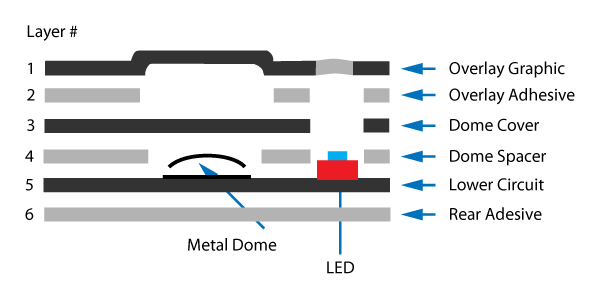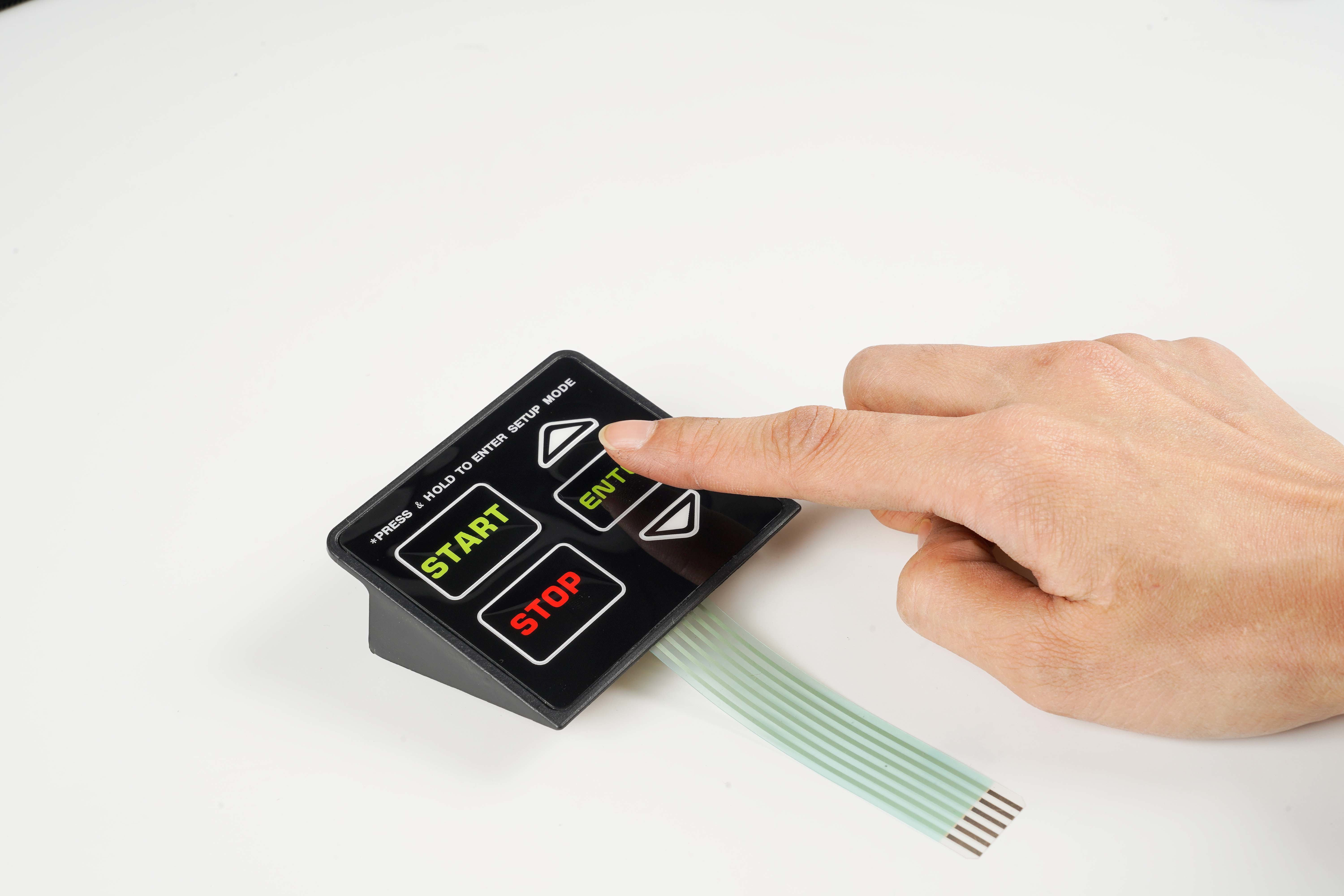All Regarding Membrane Switch Over: A Comprehensive Guide for Beginners
Membrane layer switches are crucial elements in modern-day electronics, offering an unique user interface for user communication - membrane switch. Their split building, including overlays and conductive traces, supplies functionality and toughness. Unlike standard mechanical buttons, membrane switches present a smooth layout and customizable options. Recognizing their essential attributes and advantages can change product style. The ins and outs of their application and layout considerations require further expedition.
What Is a Membrane layer Switch over?
A membrane switch is a kind of electric switch that contains an adaptable membrane layered over a printed circuit card. This layout enables for a streamlined and compact user interface, typically made use of in numerous digital gadgets. Membrane layer buttons are generally located in consumer home appliances, medical devices, and commercial machinery due to their sturdiness and resistance to environmental factors.The construction normally consists of multiple layers, such as visuals overlays and adhesive support, which give responsive feedback and safeguard the circuitry below. The procedure of a membrane button is initiated when pressure is put on the surface, finishing an electric circuit.These switches are valued for their flexibility, allowing customized designs and printed graphics that satisfy specific interface. Their inconspicuous nature decreases room needs, making them ideal for applications where typical buttons may not fit. Overall, membrane layer switches supply a useful and aesthetic option for modern digital gadgets.
Secret Parts of Membrane Switches Over
Membrane layer changes make up several essential components that add to their performance and performance. The leading layer, called the overlay, supplies the interface and is often published with graphics or signs. Underneath the overlay lies a spacer layer, which separates the conductive components and avoids unintentional activation. The following important part is the graphic layer, which improves visual appeals and assures the toughness of the design.Conductive traces, generally made from products like silver or carbon, are published on the circuit layer. When pressure is put on the overlay, these traces come into get in touch with, completing the circuit. In addition, a backing layer provides architectural support and can be made from products such as polyester or polycarbonate. With each other, these elements produce a reputable, straightforward interface suitable for various applications, from household appliances to industrial equipment. Recognizing these components is important for any individual curious about membrane layer switch innovation.
Exactly How Membrane Layer Switches Job
Recognizing just how membrane layer changes feature is crucial for valuing their prevalent use in different tools. A membrane layer button runs through a series of layers, including a visuals overlay, spacer, and a circuit layer. When stress is put on the overlay, it presses the spacer layer, permitting the circuit layer to make call and finish an electric circuit. This action sends a signal to the device, prompting a response, such as switching on a light or triggering a function.Membrane changes can be developed with various attributes, consisting of responsive comments, backlighting, and customized graphics, enhancing user communication. Their construction permits a closed style, protecting the internal parts from dirt, dampness, and pollutants. This longevity makes them appropriate for diverse applications, from customer electronic devices to industrial devices. Generally, the simplicity and performance of membrane switches over add to their popularity in modern-day technology.
Benefits of Membrane Switches Over Mechanical Switches
While mechanical buttons have actually long been a staple in lots of devices, membrane layer switches over deal distinct benefits that make them progressively appealing. One considerable benefit is their slim profile, enabling for more portable designs and greater adaptability in product advancement. In addition, membrane switches over feature an uniform surface area, which enhances aesthetic allure and simplifies cleaning, making them appropriate for settings where hygiene is critical.Another advantage is their resistance to dirt and wetness. Unlike mechanical buttons, which can be compromised by ecological elements, membrane layer switches supply a covered user interface that protects versus contaminants - membrane switch. In addition, membrane switches typically have a longer life expectancy as a result of fewer moving parts, causing enhanced longevity and reliability.Cost-effectiveness is also a significant benefit, as membrane layer buttons can be created wholesale with lower manufacturing expenses. These aspects integrate to position membrane switches as a sensible alternative to conventional mechanical options in numerous applications
Common Applications of Membrane Switches Over
Membrane layer buttons are extensively made use of in different markets, particularly in consumer electronics and commercial control board. In customer gadgets, they supply a smooth, user-friendly user interface, while in commercial settings, they enhance durability and capability. Recognizing these applications highlights the convenience and functionality of membrane buttons in contemporary technology.
Customer Electronic Devices Gadgets
As consumer electronic devices remain to advance, membrane layer buttons have come to be a prominent option for a variety of gadgets due to their convenience and streamlined design. These buttons are typically located in smart devices, tablets, and remotes, where space is restricted and looks matter. Their reduced account and personalized styles permit producers to develop user-friendly user interfaces that enhance the general customer experience. Furthermore, membrane layer buttons are typically made use of in devices such as microwaves and coffee machine, giving user-friendly control alternatives while resisting wetness and dirt. The durability and integrity of membrane layer switches over make them ideal for daily consumer items, ensuring durability and constant efficiency. Overall, their combination in customer electronic devices shows a blend of performance and modern-day layout.
Industrial Control Panels
The applications of membrane changes prolong past consumer electronic devices, locating substantial usage in commercial control panels. These switches are favored for their toughness and resistance to severe environments, making them ideal for producing and procedure control settings. They provide a reputable user interface for operators to control machinery, display procedures, and adjust settings. Membrane layer buttons can be customized to fit certain functional needs, incorporating functions click to investigate like backlighting and responsive responses, boosting customer experience. Their low-profile layout enables assimilation into different devices, while their ability to endure spills, dirt, and severe temperature levels assurances longevity. Overall, membrane buttons add to effective and safe procedure in industrial applications, demonstrating their versatility and performance sought after settings.
Factors To Consider for Designing Membrane Layer Changes
When developing membrane buttons, selecting the appropriate materials is necessary to guarantee longevity and performance. Additionally, comprehending layer arrangement methods can greatly impact the switch's efficiency and individual experience. These factors to consider play a vital role in producing trusted and efficient membrane layer switch styles.
Product Option Significance
Product option plays a crucial function in the layout and functionality of membrane buttons. The chosen materials directly impact the button's sturdiness, responsive response, and general visual. Key factors to consider consist of the substratum, which need to give structural integrity while enabling flexibility, and the graphic overlay, which needs to be resistant to use and environmental elements. Conductive materials ought to ensure reliable electrical performance, while adhesives should use solid bonding without compromising the switch's operation. Additionally, compatibility with making procedures and end-user settings is essential; products should hold up against differing temperature levels, moisture degrees, and chemical exposure. Ultimately, appropriate material choice not just improves the membrane button's efficiency however likewise contributes to its long life and individual contentment, making it a critical aspect of the design process.

Layer Setup Techniques

Regularly Asked Questions
Exactly How Long Do Membrane Changes Commonly Last?
Membrane switches normally have a life-span of 1 to 5 million cycles, relying on use and environmental conditions. Aspects such as layout top quality and operating regularity substantially influence their sturdiness and see this general efficiency durability.

Can Membrane Changes Be Custom-made for Particular Styles?
Membrane layer buttons can without a doubt be customized to suit certain styles, enabling varied forms, colors, and capabilities. This convenience enables suppliers to tailor these switches to satisfy distinct visual and operational demands properly.
What Materials Are Utilized in Membrane Change Building And Construction?
Membrane buttons are normally built making use of materials such as polyester, polycarbonate, and adhesive layers. These products provide durability, adaptability, and resistance to environmental factors, ensuring the switches operate effectively in various applications and problems.
Are Membrane Layer Switches Over Water Resistant or Immune to Moisture?
Membrane layer switches can be created to be moisture-resistant, making use of specialized products and finishings. Their water-proof capabilities depend on construction quality and details applications, making it essential to examine needs for ideal performance in different settings.
Just How Are Membrane Layer Switches Repaired if Damaged?
Repairing broken membrane changes commonly includes changing the influenced layer or circuit. Technicians may also apply conductive adhesive or utilize specialized fixing kits, ensuring capability is recovered without complete substitute of the whole button setting up. Unlike typical mechanical switches, membrane layer switches offer a smooth design and customizable alternatives. A membrane switch is a type of electrical switch that is composed of an adaptable membrane layered over a published circuit board. The operation of a membrane button is launched when stress is applied to the surface, finishing an electric circuit.These switches are valued for their flexibility, enabling click this site custom-made layouts and published graphics that cater to details customer interfaces. While mechanical switches have long been a staple in lots of gadgets, membrane layer switches offer unique advantages that make them significantly appealing. Membrane switches normally have a longer life-span due to fewer moving parts, resulting in improved sturdiness and reliability.Cost-effectiveness is additionally a notable benefit, as membrane buttons can be produced in mass with reduced manufacturing expenses.
Comments on “Can membrane switch really withstand harsh industrial environments?”